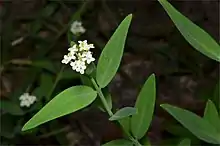| Pimelea cornucopiae | |
|---|---|
 | |
| In Cape Hillsborough National Park | |
| Scientific classification | |
| Kingdom: | Plantae |
| Clade: | Tracheophytes |
| Clade: | Angiosperms |
| Clade: | Eudicots |
| Clade: | Rosids |
| Order: | Malvales |
| Family: | Thymelaeaceae |
| Genus: | Pimelea |
| Species: | P. cornucopiae |
| Binomial name | |
| Pimelea cornucopiae | |
| Synonyms[1] | |
Pimelea cornucopiae is a species of flowering plant in the family Thymelaeaceae and is native to north Queensland and some islands to the north of Australia, New Guinea and the Philippines. It is an erect shrub with egg-shaped leaves and clusters of white or creamy-white flowers.
Description
Pimelea cornucopiae is an erect shrub that typically grows to a height of 10–50 cm (3.9–19.7 in). The leaves are narrowly egg-shaped, sometimes with the narrower end towards the base, 5–42 mm (0.20–1.65 in) long and 1.5–12 mm (0.059–0.472 in) wide. The flowers are white or creamy-white, each flower borne on a pedicel up to 5 mm (0.20 in) long, the floral tube 7–10 mm (0.28–0.39 in) long and glabrous. The sepals are usually erect, 0.8–1.3 mm (0.031–0.051 in) long and the stamens are about the same length as the sepals. Flowering occurs from February to July.[2]
Taxonomy
Pimelea cornucopiae was first formally described in 1804 by Martin Vahl in his book Enumeratio Plantarum.[3][4]
Distribution and habitat
This pimelea mainly grows in woodland or forest and occurs in near-coastal areas between the Torres Strait and Bundaberg in north Queensland, and in the Philippines, New Ireland, New Britain, New Guinea and the Louisiade Archipelago.[2]
References
- 1 2 "Pimelea cornucopiae". Australian Plant Census. Retrieved 27 August 2022.
- 1 2 "Thecanthes cornucopiae". Australian Biological Resources Study, Department of Agriculture, Water and the Environment: Canberra. Retrieved 27 August 2022.
- ↑ "Pimelea cornucopiae". APNI. Retrieved 27 August 2022.
- ↑ Vahl, Martin (1804). Enumeratio Plantarum. Vol. 1. p. 305. Retrieved 27 August 2022.